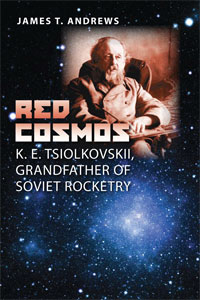Studying a legendby Taylor Dinerman
|
| The details of his life, as James Andrews explains in his new study of the man, are more complex and far more interesting than the legend. |
The details are interesting in and of their own right. Herman Oberth wrote to Tsiolkovskii in 1929: “I am sorry I did not hear about your work prior to now, or I may have been further along with my own analysis and discoveries.” Certainly the paper the Russian wrote in 1903 on rockets fueled by liquid hydrogen and liquid oxygen was far ahead of its time. His speculations about what would happen to the human body in weightlessness were equally prescient.
Most of his life was spent as a teacher of science and mathematics in his native Kaluga, southwest of Moscow. He became a teacher in spite of his lack of credentials. In 1873 he moved to Russia’s traditional capital in the hope of gaining entry into a technical school. He studied independently and became part of the circle of Nikolai Fedorov, an influential philosopher whose group “believed that through interplanetary travel, humans could achieve immortality and a quasi salvation.” (See “Resurrecting Nikolai Fedorov”, The Space Review, May 21, 2007). These ideas may have sparked Tsiolkovskii’s interest in spaceflight, but he never bothered with the mystical aspects of his mentor’s ideas.
In 1870 he managed to get hired to teach mathematics and from then until 1920 he held various teaching jobs, notably at an Orthodox girls school. By all reports he was an outstanding teacher. This talent served him well when he began a career as a popularizer of space travel and rocketry. His ability to express his exotic ideas in ways that were fairly easy to understand made him a famous and highly respected figure in the early Soviet period.
In the 1920s post-revolutionary Russia was, at least for a short time, open to avant-garde culture. Like Mussolini’s Italy, the so-called “futurist” movement of both artists and poets found that the government and the leading institutions were ready to embrace anything that gave them a patina of modernity. In both nations anything to do with aviation was used as ideological leverage in support of the regime. Tsiolkovskii was able to reinvent himself as a provincial Russian genius, ignored by the Czarists and by the pre-revolutionary scientific establishment, whose value was only appreciated by the Bolsheviks.
| This book, however, is no substitute for the comprehensive English language biography of Tsiolkovskii that is needed. |
The individual who emerges from Andrews’ study is neither a prophet nor a fraud, but essentially a man of his time. Like so many others throughout the world, he read the works of Jules Verne and H.G. Wells. He adapted to the Czarist educational system and later to the Soviet one. His own works of science fiction never gained much of a readership outside Russia, but he did write one story that included the concept of a “space cottage”, which is a nice, original way of describing a space station and one of his fictional characters was simply known as the “gravity hater”. The Communist state was all too happy to use his prestige and his ideas for its own purposes and Tsiolkovskii never complained.
Just before his death in September 1935 he wrote to Stalin, and Andrews put it, “it was really only after the 1917 Revolution that his ideas were accepted and realized—only with the help of the Communist Party.” In 1957, after the launch of Sputnik, the Khrushchev regime fashioned a image of him as Ded Cosmos (Grandfather Cosmos), buttressing the Soviet claim to be the world’s leader in science and technology.
Aside from an excessive use of fashionable academic theory, Andrews’ work is a good, solid, but minimal look at the man whose name is widely recognized but whose story has been mostly left to Russian-speaking experts. This book, however, is no substitute for the comprehensive English language biography of Tsiolkovskii that is needed. It would also have been nice to read something more about his most famous quote: “Earth is the cradle of mankind, but one does not stay in the cradle forever.”
Today, in Putin’s Russia, the space program is still an important part of that nation’s self image. Tsiolkovskii, along with Korolev and Gagarin, are powerful symbols of accomplishment. As one of the world’s major space powers, Moscow is determined to stay in the forefront of the space race, which never really ended. In spite of everything that has happened since 1991, the Soyuz and Proton rockets and Russia’s role on the International Space Station are important sources of international clout and national pride. The Kremlin has no intention of relinquishing these advantages and they owe them in no small part to the provincial schoolteacher who dreamed of rockets.
